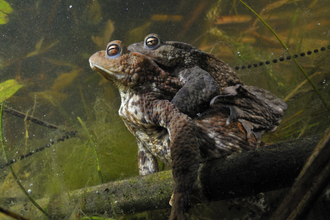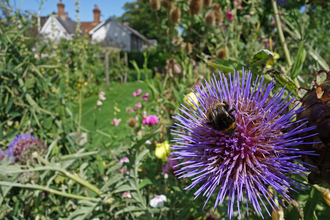Have you ever stopped to nosey in a hedge, to really notice what's scrambling its way through the branches? Or perhaps paused by the ivy sprawling up your wall to see what's feeding on the flowers or munching on the berries? Blackthorn flowers may be more colourful and hawthorn berries may be showier but ivy, the climber that thickens our hedgerows, is an outright winner for wildlife.
Ivy league plants
Red admirals on ivy by Wendy Carter
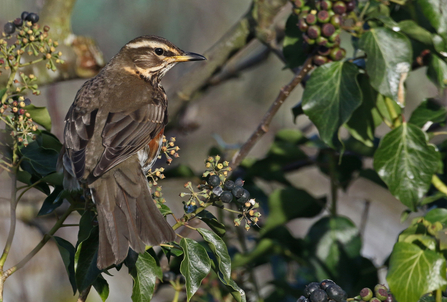
Redwing and ivy berries by Wendy Carter
Behind the bird feeder in my garden is a hedge made entirely of ivy. Well. There's a partial fence buried somewhere underneath it all but the ivy does a pretty good job of keeping itself upright and providing food and shelter for a wealth of wildlife. The sparrows love to sit and chatter amongst its foliage all year round, the bees and butterflies feed on the flowers at this time of year and, come winter, I'm often lucky that redwings spot the berries and flock to eat them. I trim it back in late winter or early spring, once the berries have all been eaten, and it always surprises me how much growth it puts back on, offering a profusion of flowers once summer turns to autumn.
It's this willingness to grow that means that ivy isn't always appreciated, especially by gardeners or managers of greenspaces who see its tenacity as a menace. Whether you love it or hate it, though, this evergreen plant is great for wildlife and we've got a long history with it too.
If its advantages for wildlife don't convince you, why not take a leaf out of the Roman attitude to ivy? It grew well over Bacchus' homeland and its ability to smother grapevines led people to believe that it could also overcome the effects of drinking too much. Cue some creativity. Whether it was wearing crowns of ivy, making drinking vessels from ivy wood or drinking wine infused with bruised ivy leaves, people would try anything to cure a hangover.
Perhaps because of its evergreen nature, it's also long been a symbol of fidelity and protection. In the past it was encouraged to grow up the walls of houses to protect those within and plaits of ivy would be hung in cattle byres to protect livestock. It's not just people or cattle that might benefit from its protection; research undertaken by English Heritage suggests that in some cases ivy could help to protect masonry from the extremes of weather and pollution.
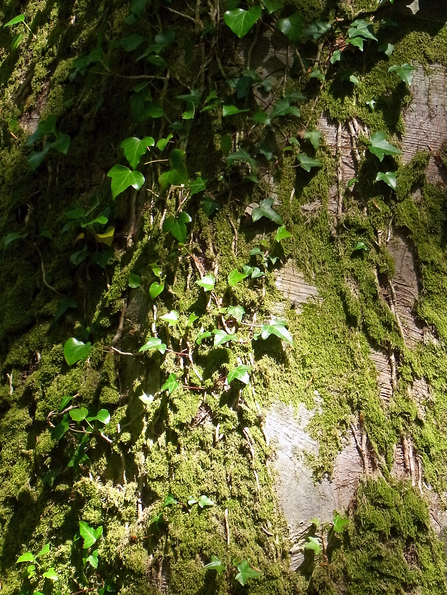
Ivy on tree by Wendy Carter
Despite popular belief, ivy isn't parasitic and it doesn't strangle trees. It does, however, need a support frame for its grippers to hang onto and its stems to wind around. Ivy only really causes a problem if it becomes heavier than its support frame or puts a tree at risk of blowing over. Look closely and you might notice that ivy has two kinds of leaf - the lobed, triangular leaves are juveniles and they seek to climb. Leaves on the flowering stems are un-lobed and its these that can grow in large numbers amongst a tree canopy, potentially causing that weighty problem
More than 100 species of invertebrates rely on ivy for food, not to mention the thick blanket of leaves that provide vital shelter and nesting opportunities for insects, birds, small mammals and more. Ivy flowers can last from June until December, making it a vital source of nectar for many of our pollinating insects. You might not even notice the flowers; they're green-ish/yellow and cluster together. As winter draws in they develop into bundles of black berries that are perfect for helping to keep our birds alive through the harsh weather.
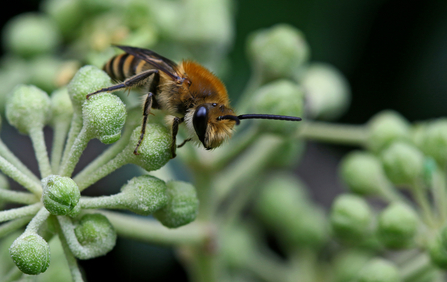
Ivy bee by Wendy Carter
There's even a bee that's named after ivy! Ivy bees arrived in Worcestershire in 2013 and have spread throughout the county. The bee larvae only eat pollen gathered from ivy and there might still be a chance to see one near you. Find some ivy flowers and spend a moment or two watching what's coming and going - look for a ginger and black bee heading to the ivy flowers.
Ivy is entering its peak phase for wildlife at the moment so if you can stand to leave it for a little longer, please do. Cut it back once the berries have been eaten; it’s a tough plant that’s not usually easily damaged; it’s the one thing in my garden that I don’t fret about if I think I’ve cut off too much. Whether growing up a garden wall, fence or through a hedgerow, ivy plays an important role in creating green corridors for wildlife to move through our landscapes.


